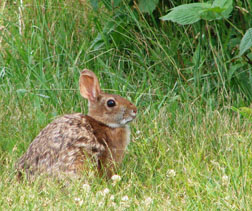 Six species of dragonfly are among the newly listed threatened and endangered species in New Jersey, according to a press release from the New Jersey Department of Environmental Protection. The changes to the list focused on flying species. Most of the animals were birds, and in addition to the dragonflies, the Indiana bat was added to the state endangered species list. (It was already on the federal endangered species list.)
Six species of dragonfly are among the newly listed threatened and endangered species in New Jersey, according to a press release from the New Jersey Department of Environmental Protection. The changes to the list focused on flying species. Most of the animals were birds, and in addition to the dragonflies, the Indiana bat was added to the state endangered species list. (It was already on the federal endangered species list.)
Non-breeding bald eagles were moved from endangered to threatened, reflecting their continued recovery in the state. Other bird species whose status was changed to reflect improved numbers are the non-breeding bird populations of osprey, peregrine falcon, red-shouldered hawk, northern goshawk, short-eared owl, and vesper sparrow, and the breeding population of Cooper’s hawk.
The black rail, golden-winged warbler and red knot were listed as endangered and American kestrel, cattle egret and horned lark were listed as threatened.
The ruling, which took effect Tuesday, also created a new category: “species of special concern.”
Read the press release here.
Read an article in the Asbury Park Press or
the Atlantic Highlands Herald.
The press release did not include the name of the dragonfly species listed, so here they are:
Endangered
Petaltail, gray (dragonfly) Tachopteryx thoreyi
Threatened
Baskettail, robust(dragonfly) Epitheca spinosa
Clubtail, banner (dragonfly) Gomphus apomyius
Clubtail, harpoon (dragonfly) Gomphus descriptus
Jewelwing, superb (dragonfly) Calopteryx amata
Snaketail, brook, (dragonfly) Ophiogomphus asperses
Earlier this month the state of California provided coverage to two species of yellow legged frogs under the California Endangered Species Act, according to a press release from the California Department of Fish and Game.
Sierra Nevada yellow-legged frog (Rana sierrae) was listed as a threatened species and the southern mountain yellow-legged frog (R. muscosa) as an endangered species, the press release reports.The frogs have disappeared from 75 percent of their historical habitats because of chytrid fungus and because they are being eaten by non-native trout.
Read a brief article on the listings in the San Jose Mercury News, here.
Read the state’s Notice of Findings here. (Very brief.)
Finally, Canada has moved to list three bat species, the tri-colored bat (AKA eastern pipistrelle), the little brown myotis (AKA little brown bat), and northern myotis (AKA northern long-eared bat) as endangered species because of white nose syndrome. Read an article in the Edmunton Journal here.
Photo: Gray petaltail by Eric Haley
 In 2009, 23 federally endangered whooping cranes died because of a drought. A recent court ruling says that this is an illegal take of a federally-endangered species, and that the federal law has precedence over Texas state law, which says that water is doled out on a first come, first served basis, says an article in Bloomberg.
In 2009, 23 federally endangered whooping cranes died because of a drought. A recent court ruling says that this is an illegal take of a federally-endangered species, and that the federal law has precedence over Texas state law, which says that water is doled out on a first come, first served basis, says an article in Bloomberg.



 When two environmental groups reached an agreement with the US Fish and Wildlife Service last year, pending court cases on the endangered species status of hundreds of species were settled as well.
When two environmental groups reached an agreement with the US Fish and Wildlife Service last year, pending court cases on the endangered species status of hundreds of species were settled as well. Last autumn, nine New England cottontails bred in captivity at the Roger Williams Park Zoo in Rhode Island were released inside a predator-proof fence enclosing one acre of the Ninigret National Wildlife Refuge, also in Rhode Island.
Last autumn, nine New England cottontails bred in captivity at the Roger Williams Park Zoo in Rhode Island were released inside a predator-proof fence enclosing one acre of the Ninigret National Wildlife Refuge, also in Rhode Island.
